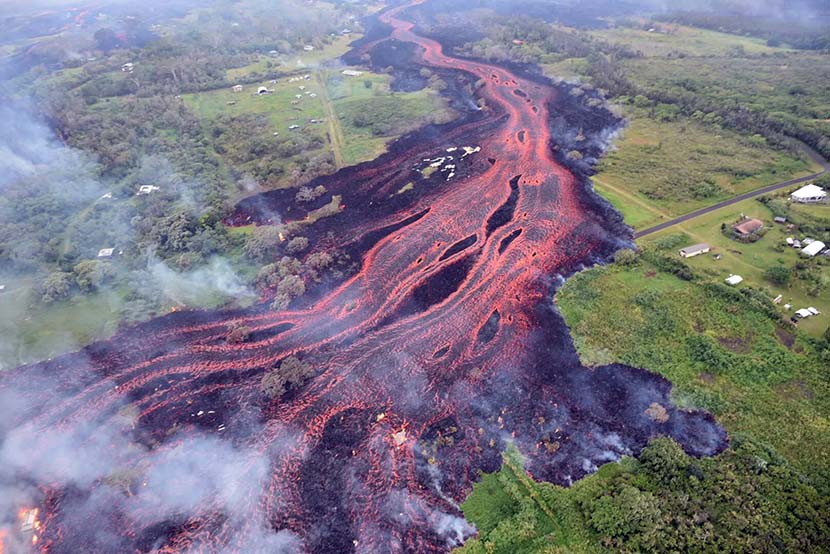Tuesday, September 17, 2024 Hawaii’s Kilauea Volcano, one of the most active volcanoes in the world, is showing signs of heightened activity, causing concern among scientists and visitors. The Hawaiian Volcano Observatory (HVO) has raised the Volcano Alert Level from an “advisory” to a “watch” due to a surge in earthquake activity, ground deformation, and gas emissions over the weekend. The U.
S. Geological Survey (USGS) also increased the aviation color code for the volcano from “yellow” to “orange,” indicating that an eruption could be imminent, although Kilauea is not currently erupting. The alert came after magma intrusion was detected in the middle East Rift Zone of Kilauea on September 14, 2024, raising the potential for an eruption in this remote area located within Hawaii Volcanoes National Park.

The recent volcanic activity started with intense earthquakes and localized ground deformation patterns detected between Maunaulu and Makaopuhi Crater on Saturday evening, according to the USGS. These signs are indicative of underground crack growth caused by magma moving beneath the surface. As of Monday morning, earthquake rates and ground deformation had increased significantly, prompting the Hawaii Volcanoes National Park to close certain areas as a precautionary measure in case of an eruption.
According to the USGS Hawaiian Volcano Observatory , approximately 60 earthquakes have been detected in the area since the intrusion of magma was identified, with the largest earthquake recorded at a magnitude of 4.3 . Although seismic activity has increased, the area affected remains remote, minimizing any direct threats to populated areas.
In addition to the earthquakes, infrasound instruments on Sunday night detected a strong signal that is typical of gas or steam venting . Seismometers in the middle East Rift Zone have also recorded weak, sustained low-frequency tremors , a sign that further magma movement or eruptions could occur. However, heavy rainfall in the area is complicating efforts to interpret some of these seismic signals, making it difficult to fully understand the extent of the activity at Kilauea.
The area surrounding the Chain of Craters Road, a popular route in Hawaii Volcanoes National Park, has been closed due to heightened gas emissions and the potential hazards of volcanic unrest. The park is advising visitors to check the Hawaii Volcanoes National Park website for up-to-date information about closures and safety hazards. Kilauea’s history of volcanic activity suggests that any forthcoming eruption could be small in scale, depending on how the magma moves through the rift zone.
The USGS reported that in 2007 , a similar magma intrusion in this region produced a small pad of lava , roughly the size of half a football field , that erupted without any significant impact. Numerous other eruptions took place in the 1960s and 1970s , many of which lasted anywhere from one day to two weeks . Given the current signs of unrest, experts caution that a small-scale eruption could occur under similar circumstances without prior warning.
Nevertheless, the current conditions warrant increased caution, especially as the earthquake activity and gas emissions continue to rise. Kilauea most recently erupted on June 3, 2024 , when lava emerged four kilometers southwest of its caldera. That eruption, which occurred within Hawaii Volcanoes National Park , lasted only a few hours, but still served as a reminder of the volcano’s unpredictable nature.
The June eruption was relatively minor and did not result in any significant damage, but it highlights the constant potential for activity at Kilauea. While the current magma intrusion and rising earthquake activity may not guarantee a significant eruption, officials are urging visitors and locals alike to be vigilant, as the volcanic landscape can change rapidly. With increased volcanic activity comes a growing focus on safety for both visitors and staff at Hawaii Volcanoes National Park .
As a precaution, the park has closed Chain of Craters Road to prevent any hazards to visitors due to elevated gas emissions and the potential for sudden volcanic events. Park authorities are also urging visitors to stay informed by checking the park’s website regularly for closure updates , hazard alerts, and safety information . Given Kilauea’s ongoing volcanic unrest, it is important for travelers to plan ahead and take the necessary precautions before visiting the park.
For travelers planning to visit Hawaii Volcanoes National Park in the coming weeks, understanding the current situation and taking the necessary precautions is crucial. Here are some key considerations: Despite the current unrest, Kilauea Volcano remains a major attraction for tourists visiting Hawaii’s Big Island . Known for its rich geological history and frequent volcanic activity, Kilauea is one of the most active volcanoes in the world and offers visitors the chance to witness the powerful forces of nature up close.
Even with the increased risk of volcanic activity, tourists continue to flock to Hawaii Volcanoes National Park to explore its unique landscapes, lava fields , and historic sites like the Kilauea Caldera and Halema’uma’u Crater . As long as travelers exercise caution and stay informed about the current volcanic conditions, they can still experience the awe-inspiring beauty of Kilauea while ensuring their safety. As Kilauea shows signs of increased volcanic activity, both locals and tourists are advised to remain vigilant and informed.
The USGS and HVO continue to monitor the situation closely, offering real-time updates and raising alert levels as necessary. While the potential for an eruption remains uncertain, the activity within Kilauea’s East Rift Zone serves as a reminder of the dynamic and unpredictable nature of Hawaii’s volcanic landscape. For those planning to visit Hawaii Volcanoes National Park, it is essential to stay updated on park alerts and potential hazards to ensure a safe and enjoyable experience.
.




















